Casualties and Data Collection
1999–2009 Overview
Landmine Monitor has identified at least 73,576 casualties in 119 countries/areas in the past 10 years. The total number of survivors worldwide is not known but is estimated to be in the hundreds of thousands. This figure includes at least 5,197 casualties caused by mines, explosive remnants of war (ERW), and victim-activated improvised explosive devices (IEDs) in 2008, slightly fewer than the 5,473 casualties recorded in 2007. This decrease was markedly less than in most previous years of the past decade. As before, these figures were incomplete due to inadequate or non-existent data collection.
Casualties from 1999–2008
Despite data collection challenges, Between 1999 and the end of 2008, Landmine Monitor collected information on 73,576 recorded mine/ERW/IED casualties in 119 countries and areas, of which 17,867 were killed, 51,711 injured, and 3,998 of unknown status.[1]
While tragically high, the number of casualties in the past decade is incomplete because it includes only recorded casualties. There was certainly under-reporting throughout the decade due to the lack of adequate data collection mechanisms worldwide, a lack of retrospective data collection, and under-reporting of certain groups of casualties, such as foreign nationals, refugees or internally displaced persons, non-state armed groups (NSAG), or ethnic minorities. Mine/ERW casualties during conflicts are also under-reported.
Also, many countries with mine/ERW contamination transitioned out of conflict prior to 1999, meaning that most of their casualties would also have occurred before 1999, for example in Bosnia and Herzegovina (BiH), Burundi, Cambodia, Croatia, Egypt, El Salvador, Lao PDR, Mozambique, Nicaragua, Syria, or Vietnam.
A regional breakdown of the total global casualties recorded by Landmine Monitor from 1999–2008 is set out in the table below.
Casualties by Region, 1999–2008
|
Region and no. of states |
No. of states with casualties |
No. of casualties |
|
Asia-Pacific (40) |
21 |
33,627 |
|
Africa (48) |
32 |
16,390 |
|
Middle East and North Africa (18) |
17 |
8,558 |
|
Americas (35) |
14 |
7,202 |
|
Commonwealth of Independent States (12) |
12 |
4,628 |
|
Europe (42) |
23 |
3,171 |
|
Total |
119 |
73,576 |
Most casualties (49,617 or 67%) occurred in 82 States Parties. Among States Parties, nine in every 10 casualties happened in the so-called VA26 countries (44,694).[2] Some 26% of total casualties during the decade happened in just two countries: Afghanistan (16%) and Cambodia (10%). In states not party and areas not internationally recognized there were 23,755 casualties.[3]
States with 1,000 casualties or
more from 1999-2008
|
State |
Total 1999–2008 |
|
Afghanistan |
12,069 |
|
Cambodia |
7,300 |
|
Colombia |
6,696 |
|
Iraq |
5,184 |
|
India |
2,931 |
|
Russia |
2,795 |
|
Angola |
2,664 |
|
Somalia |
2,354 |
|
Myanmar |
2,325 |
|
Lao PDR |
2,295 |
|
Pakistan |
1,969 |
|
Ethiopia |
1,947 |
|
Sudan |
1,748 |
|
Congo, Democratic Republic of (DRC) |
1,696 |
|
Vietnam |
1,545 |
|
Sri Lanka |
1,272 |
Recorded casualties reduced gradually throughout the decade from more than 8,000 per year between 1999 and 2003, to just over 7,000 in 2005, and fewer than 5,500 per year since 2007.
Among the VA26 countries, 71% of casualties where the civil/military status was known were civilians and 2% were humanitarian deminers. Additionally, 24% were security forces (the majority in Colombia), and 3% were paramilitary or NSAGs.
When the age was known, 68% of casualties were adults and 32% were children. The vast majority of casualties were male (90%) and men made up the largest casualty group (63%), followed by boys (27%), then women and girls (5% each).
Some 44% of casualties were caused by ERW (excluding cluster munitions), 30% by antipersonnel mines, 13% by unspecified mines, 10% by antivehicle mines, 2% by cluster submunitions, and the remainder by victim-activated IEDs (less than 1%).[4]
At least 34% of casualties where the activity at the time of the incident was recorded occurred during livelihood activities. Some 20% of casualties happened by directly interacting with an explosive device and 18% occurred while traveling.
Casualties in 2008[5]
In 2008, Landmine Monitor identified 5,197 recorded casualties caused by mines, ERW and victim-activated IEDs.[6] Some 1,266 people were killed, 3,891 injured, and the status of 40 people was unknown.Casualties in 2008 were recorded in fewer countries and areas than in 2007: 75 compared to 78. Ten countries with recorded casualties in 2007 did not record any casualties in 2008, most notably Mauritania, which had recorded casualties every year since 2000.[7] Seven countries that did not record casualties in 2007 suffered casualties in 2008,[8] including Libya, where Landmine Monitor identified casualties for the first time since 1999 (despite regular but unconfirmed reports of high casualty rates). Casualties again occurred in Mali, which recorded its first-ever casualties in 2007, and in Niger, which had not recorded casualties for several years before 2007.
States and other areas with mine/IED/ERW casualties in 2008[9]
|
Africa |
Americas |
Asia-Pacific |
Europe |
Commonwealth of Independent States |
Middle East and North Africa |
|
Angola |
Colombia |
Afghanistan |
BiH |
Azerbaijan |
Algeria |
|
Burundi |
El Salvador |
Bangladesh |
Croatia |
Belarus |
Egypt |
|
Chad |
Nicaragua |
Cambodia |
Cyprus |
Georgia |
Iran |
|
Côte d’Ivoire |
Peru |
China |
Greece |
Kyrgyzstan |
Iraq |
|
DRC |
US |
India |
Montenegro |
Moldova |
Israel |
|
Eritrea |
Indonesia |
Poland |
Russia |
Jordan |
|
|
Ethiopia |
Korea, South |
Serbia |
Tajikistan |
Kuwait |
|
|
Guinea-Bissau |
Lao PDR |
Turkey |
Ukraine |
Lebanon |
|
|
Kenya |
Malaysia |
Kosovo |
Abkhazia |
Libya |
|
|
Mali |
Mongolia |
Nagorno-Karabakh |
Morocco |
||
|
Mozambique |
Myanmar/Burma |
Syria |
|||
|
Niger |
Nepal |
Yemen |
|||
|
Rwanda |
Pakistan |
Palestine |
|||
|
Senegal |
Philippines |
Western Sahara |
|||
|
Somalia |
Sri Lanka |
||||
|
Sudan |
Thailand |
||||
|
Uganda |
Vietnam |
||||
|
Zambia |
|||||
|
Zimbabwe |
|||||
|
Somaliland |
|||||
|
19 states, |
5 states |
17 states |
8 states, |
8 states, |
12 states, 2 areas |
In earlier years there was an average annual decrease of at least 9%, but casualty rates in 2008 were 5% lower than 2007.[10] It is even possible that 2008 will be the first year since 2005 in which there is no decrease in the casualty rate compared to the previous year. This is because 2008 casualty figures only include casualties recorded in formal data collection mechanisms and identified by Landmine Monitor through other means, which are incomplete in nearly all countries (see Data collection section below). Additionally, data collection is slow in many countries/areas, meaning that casualties are “discovered” long after the incident date.[11]
Casualty demographics
Casualties in 2008 by Civilian/Military Status
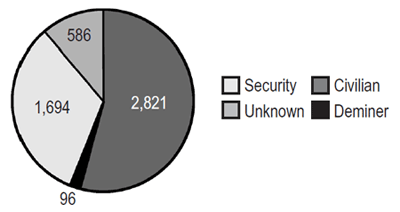
Casualties in 2008 by Gender
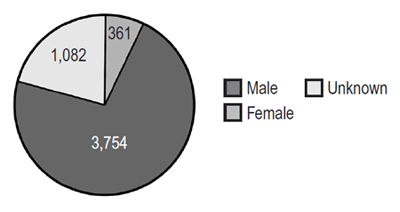
Casualties in 2008 by Age
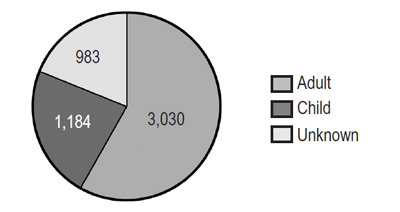
In 2008, some 61% of casualties (where civilian/military status was known) were civilians (2,821 of 4,611).[12] While civilians still make up most casualties, as a percentage of total casualties they continued to decrease from 71% in 2007 and 81% in 2005.[13] This is mainly due to the high number of military casualties in Colombia (507) and Myanmar (508). Other reasons were possible over-reporting of military casualties in the media and major incidents causing multiple military casualties. In total, there were 1,694 casualties among security forces, with Colombia and Myanmar accounting for 60% of these casualties.
There were 96 demining casualties in 14 countries in 2008, a 20% decrease compared to 2007, when there were 120 casualties.[14] By far the most clearance casualties occurred in Afghanistan (51 casualties, 53% of all demining casualties in 2008), followed by BiH (eight, but 30% of total mine/ERW casualties in that country), Iran (eight), and Cambodia and Iraq (seven each). The drop is largely due to a sharp decrease in demining casualties in Cambodia (seven, down from 17 in 2007) and Lebanon (one, down from 16). Just one female demining casualty was recorded in Mozambique. In addition, among the total military casualties, 12 were conducting clearance when the incident occurred.
The vast majority of casualties where the gender was known were male (3,754, or 91% of 4,115), 361 were female (9%). The gender of 1,082 recorded casualties was unknown (21%, compared to 19% in 2007). For civilian casualties only, females made up 12% of casualties (309 of 2,478 where the gender is known). Females were the majority casualty group in three countries (Bangladesh, Mozambique, and Rwanda), but this was related to specific incidents causing multiple casualties and not to a pattern of activities putting women at particular risk.
In Lao PDR, Nepal, Somaliland, and Yemen, the percentage of female casualties was significantly higher than the 2008 average, because certain livelihood activities that women typically engage in put them at higher risk. For example, in Yemen women traditionally tend the animals or collect water, food or wood. In both Lao PDR and Nepal, women are more extensively involved in scrap-metal collection or related activities.
Children accounted for 28% of casualties where the age was known (1,184 of 4,214). For some 19% of people, no age information was known (983). For civilian casualties only, children constituted 41% of casualties where the age was known.[15] Nearly three-quarters of child casualties were boys (869) and 193 were girls; the gender of 122 child casualties was not known. In an increasing number of countries and areas, boys were the single largest casualty group: Chad, El Salvador, Eritrea, Jordan, Lao PDR, Nepal, Somalia, Somaliland, Sudan, and Yemen (compared to just three countries in 2007: Chad, Kosovo, and Lao PDR). In Afghanistan, nearly half of all civilian casualties were boys, a significant increase compared to 2007.
For all adult casualties, 93% were men (2,828 of 3,030), but less than half of these men were civilians (1,358 or 48% of adult male casualties). Some 5% of casualties were women (164), including 137 civilians (84% of adult female casualties).[16]
Devices causing casualties
In more than one-quarter of cases, the device that caused the casualty was unknown (1,342). For the 3,078 cases where the device type was known:[17]
- antipersonnel mines caused 715 casualties (23%), a decrease compared to 25% in 2007;
- antivehicle mines caused 440 casualties (14% up from 13% in 2007);
- unspecified mines caused 486 casualties (16% up from 11% in 2007);
- cluster munitions caused 125 casualties (4% down from 5% in 2007);[18]
- other ERW caused 1,227 casualties (40% up from 36% in 2007); and
- victim-activated IEDs caused 80 casualties (below 3%, down from some 10% in 2007).[19]
ERW casualties (excluding those caused by cluster munitions) occurred in 49 states/areas, antipersonnel mines casualties in 31 countries, antivehicle mines casualties in 19, victim-activated IEDs in 10, and cluster munitions casualties in nine.
Where age was known, most antipersonnel mine casualties were adults (80%).[20] Nearly all adult antipersonnel mine casualties were men (94%), including 54 deminers. Civilians were most affected by antipersonnel mines in Cambodia, Myanmar, and Pakistan. Similarly, most casualties caused by antivehicle mines were adults (88%), and 95% of these were men. Civilians traveling were at particular risk from antivehicle mines in Afghanistan and Pakistan.
Casualties in 2008 by Device
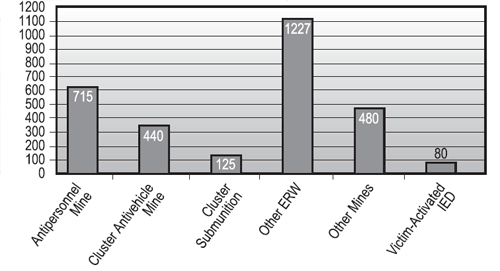
As in previous years, cluster munitions were the only device type where the child-adult ratio was 50-50. Lao PDR was the only severely affected country where children constituted the largest group of cluster munition casualties. In Cambodia, which is less-affected by unexploded submunitions than Lao PDR, children also made up the largest group of cluster munitions casualties.
Cassualties in 2008 by Age and Device
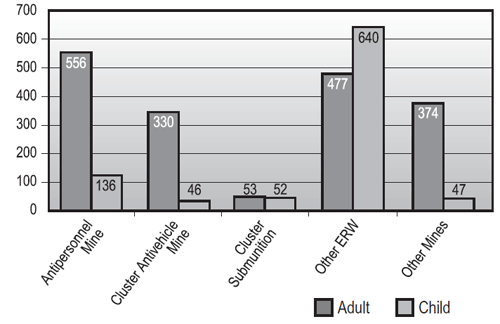
When looking at ERW other than cluster munitions, the majority of casualties were children (57%).[21] When the gender was known, some 45% of ERW casualties were boys, 42% men, 9% girls and 4% women. Boys were particularly affected by ERW in Afghanistan, Cambodia, Chad, Eritrea, Lao PDR, Nepal, Sudan, and Yemen.
Activity at time of incident
While in many cases crucial information about the activities being carried out by casualties at the time of the mine/ERW incident is lacking, Landmine Monitor was able to collect this type of information for 3,617 (or 70%) of the casualties it identified. Due to the large percentage of military casualties, “security” was the most common type of activity (1,305), although security forces were also involved in incidents, for example while traveling, carrying out clearance, tampering with devices, and handling devices.
The second most common activity at the time of incidents was traveling (516), most often caused by antivehicle mines (44%) or antipersonnel mines (23%).
This was followed by tending animals (247), standing near/passing by during an incident (207), playing/recreation (197) and collecting food/wood/water (182). All livelihood activities combined resulted in 651 or 18% of casualties for whom activity information is known;[22] 92% of those carrying out livelihood activities were civilians (602). Some 56% of casualties occurring during livelihood activities were adults and 44% were children. Most livelihood casualties were caused by mines (311), usually antipersonnel mines (210). But children were much more at risk from ERW during livelihood activities. These figures exclude those deliberately dealing with explosive devices for economic gain.
Activities involving people who, intentionally or unintentionally, interact directly with explosive devices caused 452 casualties. These include 188 people tampering, 145 people handling explosive devices (excluding demining accidents), 88 people collecting scrap metal, 29 playing and two burning explosive devices. It needs to be noted that many casualties among those fishing or tending animals probably also involved deliberate handling of explosive devices. This could explain why children were at more risk from ERW than from mines while conducting livelihood activities. Three-quarters of casualties in which the device was handled were caused by ERW, and casualties were usually male (85%). The largest casualty group was boys (45%), followed by men (40%), girls (10%), and women (5%). Boys are particularly at risk in Cambodia and Nepal (where girls were also at high risk). Scrap metal collection became an increasing problem among men in Egypt.
Other activities causing casualties were coca eradication (68 in Colombia) and portering/forced labor (eight in Myanmar).
Regional distribution
Casualties were recorded in every region of the world in 2008 (see table below). There were significant increases in the Asia-Pacific region and in the Commonwealth of Independent States (CIS).
|
Region |
2008 |
2007 |
||
|
No. of casualties |
No. of countries/areas with casualties |
No. of casualties |
No. of countries/areas with casualties |
|
|
Africa |
705 |
20 |
954 |
24 |
|
Asia-Pacific |
2,813 |
17 |
2,495 |
15 |
|
Americas |
805 |
5 |
982 |
7 |
|
Commonwealth of Independent States |
155 |
10 |
118 |
10 |
|
Europe |
178 |
9 |
238 |
9 |
|
Middle East and North Africa |
541 |
14 |
686 |
13 |
The 26 States Parties responsible for significant numbers of survivors accounted for 55% of total casualties in 2008 (2,867) and just two of these countries (Afghanistan and Colombia) accounted for 34% of total casualties (1,769).
Casualties in 2008 by Region
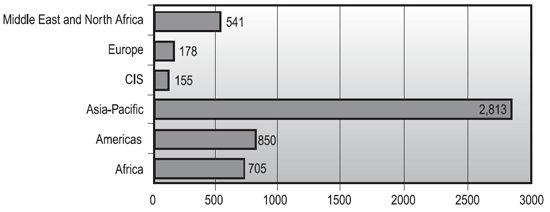
In 2008, 35 countries recorded increased casualties compared to 2007, in some cases significantly, for example in Egypt (40 up from 25), Iraq (263 up from 216), and Pakistan (341 up from 271).
Trends in States with 100 or
More Casualties in 2008
|
State |
Casualties in 2008 |
Casualties in 2007 |
|
Afghanistan |
992 |
842 |
|
Colombia |
777 |
904 |
|
Myanmar |
721 |
438 |
|
Pakistan |
341 |
271 |
|
Cambodia |
269 |
352 |
|
Iraq |
263 |
216 |
|
Chad |
131 |
188 |
|
Somalia |
116 |
74 |
|
Lao PDR |
100 |
100 |
|
Turkey |
100 |
101 |
- Afghanistan also saw the first increase in casualties since 2005 making it the country with the highest number of casualties in 2008 (992 up from 842).
- In Georgia casualties increased due to the 2008 conflict (to 26 up from three the previous year).
- In Myanmar the increase was due to access to information about military casualties (721 up from 438).
- In 37 countries there were fewer casualties in 2008 than in 2007, for example in Chad, Nepal, and Vietnam.
- Cambodia continued the downward trend started in 2006 (269 down from 352 in 2007); the 2008 rate is only 31% of the 2005 rate when 875 casualties were recorded.
- In Colombia the decline in casualties started in 2007 continued (777 down from 904), the first time since 2005 that it is not the country with the most casualties.
- In Lebanon, for the first time since the 2006 conflict, casualties returned to levels similar to 2005 (28 down from 130 in 2007 and 207 in 2006).
- In many other countries, however, decreased casualty rates were at least partly attributable to worse data collection, for example in Burundi, Ethiopia, and
Namibia.[23]
New casualties in 2009
Casualties continued to be recorded in 2009, in at least 59 countries and areas as of September 2009, including three countries where no casualties had been recorded in 2008 (Albania, Japan, and Uzbekistan).[24] In Chechnya, Guinea-Bissau, and Western Sahara the recorded totals were almost as high or higher than the annual total for 2008.
Data Collection
In 1999, Landmine Monitor noted that, “Concrete information on mine victims remains difficult to obtain” and “seriously lacking.”[25] In 1999, most available information was patient information from ICRC rehabilitation programs, thus not actual casualty data. Landmine Monitor also noted that data collection methods “can do more harm than good if they proliferate and are not closely linked to action that is tangible to the survivor community.”[26]
In 2009, it is accepted that comprehensive casualty data is crucial to understanding the scope of the challenges and the needs of survivors. The main purpose of casualty (and service) data collection is its use for planning purposes, not only for victim assistance but also other mine action tasks (such as clearance and mine/ERW risk education).
While data collection has improved since 1999, Landmine Monitor has reported consistently throughout the decade that mine/ERW casualties are certainly under-reported because of inadequate data collection mechanisms, inaccessible terrain, conflict, under-reporting of fatal casualties, fear, or political sensitivities.
Still, 28 of 75 countries/areas with casualties in 2008 did not have formal data collection mechanisms, including some with persistently high casualty figures, for example Iran, Myanmar, and Pakistan, or to a lesser extent Algeria, and Uganda. These 28 countries accounted for 1,408 casualties in 2008 (or 27% of the total–up from 25% in 2007 and 19% in 2006), which Landmine Monitor mainly identified through media reports. The remaining 47 countries/areas had data collection systems, and 29 of these used the Information Management System for Mine Action (IMSMA) to store data collected.[27]
However, even when data collection mechanisms existed, these were incomplete in the vast majority of countries (43). Only in Cambodia, Jordan, Kosovo, and Tajikistan could casualty data for calendar year 2008 be considered “complete.” These accounted for 306 casualties (6%) in 2008, meaning that 94% of casualties in 2008 were recorded in countries with incomplete or no data collection (up from 93% in 2007 and from 92% in 2006). Another country with complete data collection, Albania, recorded casualties in 2009. Through media, hospital or NGO information, Landmine Monitor identified additional casualties that were not recorded in 28 of the 47 countries with data collection mechanisms in 2008 (955 or 18% of total casualties).
When data collection mechanisms exist, the most common problems were: limited geographic and demographic coverage; a lack of standard methodology, terminology or types of information collected; a lack of useful detail on devices, demographics, socio-economic indicators, or activities; a lack of capacity impeding proactive data collection; poor quality control and verification; and multiple actors collecting overlapping and contradictory data in separate databases. Further problems are that casualty data is insufficiently linked to contamination or victim assistance data, data is not shared for planning purposes or linked to referral mechanisms, resulting in data collection for compilation purposes rather than the provision of assistance.
Conclusion
Although recorded casualties have decreased significantly over the past five years, the number remains unacceptably high—there were still more than 5,000 recorded casualties in 2008. This is a far cry from the common estimate of 26,000 per year in the 1990s—even if it is not possible to gauge the accuracy of that estimate. For we will never know exactly how many people were killed or injured by mines or ERW returning to Afghanistan, gathering food in Angola, or growing rice in Cambodia. What is certain is that casualty data collection still remains inadequate in many countries. It is a fundamental responsibility of states to assist those most directly affected by mines and ERW, and a pre-requisite to such assistance is an accurate determination of the number of survivors as well as the dependants of those who did not survive.
[1] These figures only include casualties occurring on a country’s territory, and only include some of the many casualties among soldiers, peacekeepers, deminers or humanitarian workers from many other countries, for example Australia, France, Netherlands, the United Kingdom, or the United States.
[2] This is the informal name given to the 26 States Parties with significant numbers of survivors, and, therefore, with the greatest responsibility to act but also the greatest needs and expectations for assistance: Afghanistan, Albania, Angola, BiH, Burundi, Cambodia, Chad, Colombia, Croatia, DRC, El Salvador, Eritrea, Ethiopia, Guinea-Bissau, Iraq, Jordan, Mozambique, Nicaragua, Peru, Senegal, Serbia, Sudan, Tajikistan, Thailand, Uganda, and Yemen. For further details, see the Victim Assistance chapter.
[3] In Poland, the only Mine Ban Treaty signatory with casualties, 204 casualties were reported between 1999 and 2008.
[4] These figures do not include casualties from explosive devices, such as cluster munitions, at the time of attacks. They do include casualties from ERW and from mines during conflict.
[5] Figures include individuals killed or injured in incidents involving devices detonated by the presence, proximity, or contact of a person or a vehicle, such as all antipersonnel mines (whether factory or home-made), antivehicle mines, unexploded ordnance, abandoned explosive ordnance, victim-activated IEDs and vehicle-activated IEDs. Not included in the totals are: estimates of casualties where exact numbers are not given; incidents clearly caused by remote-detonated mines or IEDs; and devices that were clearly not victim-activated. Also not included are people killed or injured while manufacturing devices. For some countries, such as Iraq or India, where verification of reported incidents was particularly difficult, even stricter criteria were applied as IED incidents were only included if the device was set off by direct (hand or foot) contact.
[6] This figure is the number of casualties recorded in formal data collection mechanisms and/or identified by hospitals, NGOs, or through the media. The actual number of casualties is certainly higher, as many countries do not have data collection mechanisms, data collection is not nationwide, does not include all groups of the population, or is hampered by security or geographic difficulties.
[7] The 10 countries without new casualties were Albania, Armenia, Chile, France, Gambia, Honduras, Latvia, Mauritania, Namibia, and South Africa.
[8] The seven countries with new casualties were Bangladesh, Cyprus, Greece, Libya, Malaysia, Moldova, and Montenegro.
[9] IED refers to victim-activated improvised explosive device.
[10] Landmine Monitor Report 2008 identified 5,426 casualties in 78 countries and areas in 2007. Due to slow data collection and data verification the total of 5,426 was revised to 5,473, with changes in Afghanistan, Azerbaijan, Chad, Colombia, Georgia, Jordan, Nagorno-Karabakh, Niger, Russia, Sri Lanka, and Tajikistan.
[11] For example in 2008, Landmine Monitor identified 256 additional casualties for 2006 in Afghanistan alone compared to data available in 2007. This data was made available to Landmine Monitor only in mid-2008. Casualty updates for 2008 have already been received from several countries, including Afghanistan, Cambodia, Chad and Colombia in early September 2009, which could not be included due the incomplete nature of the data provided.
[12] The civilian/military status of 586 casualties was unknown.
[13] See Landmine Monitor Report 2008, p. 53.
[14] The 14 countries with demining casualties included Afghanistan, BiH, Cambodia, Croatia, Cyprus, Iran, Iraq, Lebanon, Mozambique, Nicaragua, Sri Lanka, Sudan, Tajikistan, and Yemen.
[15] This equals 1,040 civilian child casualties of 2,566 civilian casualties where the age was known. In addition to this there were a few child soldier casualties and several children for whom the civilian/military status could not be determined.
[16] For 38 adults no gender details were known.
[17] As in all previous years, casualties from Colombia (777) were also excluded, because casualties are incorrectly labeled as caused by antipersonnel mines.
[18] As in all previous years, this does not include direct casualties from cluster munition strikes.
[19] An additional five casualties were caused by an IED that was vehicle-activated, thus functioning as an antivehicle mine.
[20] 556 of the 692 antipersonnel mine casualties whose age was known.
[21] 640 of 1,117 ERW casualties where the age was known, excluding cluster munitions.
[22] This increases to 28% when excluding the casualties resulting from “security” activities from the total number of casualties where the activity at the time of the incident is known.
[23] In three countries (Israel, Lao PDR, and Syria) there were just as many casualties in 2008 as in 2007.
[24] In 2009, Landmine Monitor identified five new ERW casualties, one killed and four injured in two incidents in Okinawa, Japan. Three of these casualties occurred on 24 March 2009, in the worst incident since 1974. A US marine was killed and another marine and sailor were injured while disposing of ordnance at an US military facility. Eric Talmadge, “60 years after Second World War, Okinawa still rife with bombs,” The Canadian Press, 3 May 2009.
[25] See Landmine Monitor Report 1999, p. 19.
[26] Ibid, p. 20.
[27] In comparison Landmine Monitor Report 2003, p. 40, reported that, “Of the 65 countries, and seven areas, reporting new mine casualties in 2002–2003, only 25 countries and four areas report using IMSMA, or other databases, to record casualty data. Of those, only 18 countries and two areas provided Landmine Monitor with full year data.”






